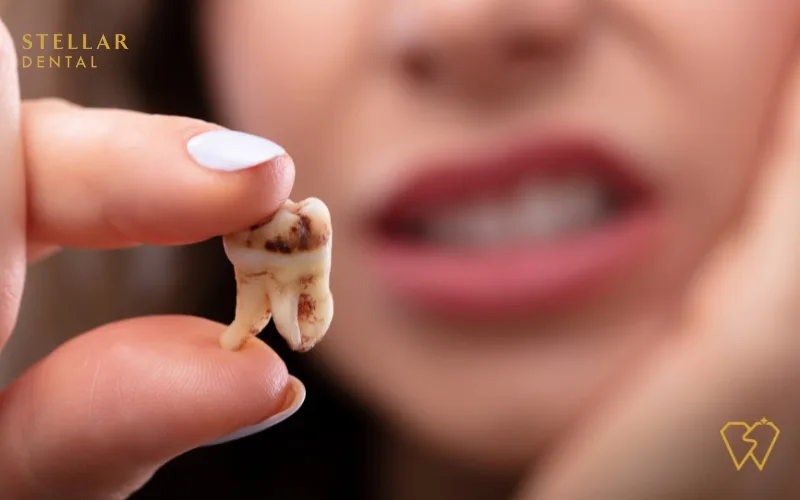Tooth decay is a widespread and frequently neglected issue affecting millions worldwide. Despite its prevalence, many individuals do not understand what causes tooth decay, how to identify its symptoms, and most importantly, how to prevent it. It is a painful and potentially dangerous condition that can lead to serious oral health problems, such as tooth loss, tooth infection, and gum disease. This article provides comprehensive information on tooth decay, including its causes, symptoms, and preventative measures.

What exactly is tooth decay?
Tooth decay is when the enamel and dentin of your teeth break down, resulting in small holes or cavities. Plaque forms on the teeth when the sugars and starches in food combine with saliva. Bacteria produce acids that can erode enamel and cause tooth decay over time.
However, tooth decay is not merely the result of plaque accumulation. It results from a complex interaction of factors, including diet, oral hygiene, genetics, and certain medical conditions. In other words, tooth decay is caused by a combination of factors, each of which contributes to the decay.
Causes of tooth decay
The causes of tooth decay include:
Bacteria
Bacteria are one of the primary causes of tooth decay. The mouth has a complex ecosystem of both beneficial and harmful bacteria. When the sugars and starches in the food we eat combine with saliva, they form plaque, a film of bacteria that adheres to the teeth. Plaque bacteria produce acids that can erode enamel and lead to tooth decay.
Poor oral hygiene
Inadequate oral hygiene is another critical factor in the onset of tooth decay. Lack of regular brushing and flossing can lead to the accumulation of plaque and tartar, which can erode the enamel and cause cavities. Neglecting regular dental checkups can prevent early detection and treatment of decay, allowing it to progress and cause more serious oral health problems. Good oral hygiene can help prevent the accumulation of plaque and reduce the risk of tooth decay.
Dietary habits
Your dietary habits can also contribute to the development of tooth decay. High consumption of sugary, sticky and starchy foods and beverages can increase the risk of plaque accumulation and tooth decay. In addition, sipping sugary drinks throughout the day can keep the mouth in a constant acidic state, eroding the enamel and leading to tooth decay.
Genetics
Genetics can also play a role in the development of tooth decay. Some individuals have a genetic disposition toward tooth decay, making them more susceptible to the condition. This can make it even more critical for these individuals to maintain good oral hygiene and a healthy diet to reduce their risk of tooth decay.
Medical conditions
Certain medical conditions can also increase the risk of tooth decay. As saliva helps to neutralize the acids produced by plaque, individuals with a dry mouth or low saliva production are more prone to tooth decay. Additionally, certain medications can increase the risk of tooth decay by decreasing saliva production or altering the bacterial balance in the mouth.
Symptoms of tooth decay
Toothache
Toothache is a common sign of tooth decay, which is the progressive deterioration of the tooth enamel and underlying structures. While tooth decay reaches the innermost layer of the tooth, it can cause pain and discomfort, especially when eating hot or cold foods or beverages. Constant or intermittent, the pain might range from mild to severe. Toothache is an obvious sign that a tooth has decay and requires immediate attention from a dental professional.
Sensitivity
Sensitivity is another common symptom of tooth decay, which can occur when the progressive destruction of decay compromises a tooth’s enamel. This sensitivity can be intense, brief, or persistent and ranges from mild to severe. Sensitivity is another clear sign of tooth decay.
White or brown stains
These stains may indicate the presence of tartar or plaque, which can erode enamel and lead to tooth decay. In rare cases, these stains may indicate an underlying medical issue, such as an autoimmune disease or vitamin deficiency. If you observe white or brown stains on your teeth, you must consult a dentist to diagnose the underlying cause and maintain your oral health.
Bad breath
When oral bacteria begin to decompose food particles, they generate foul-smelling gases that can lead to bad breath. Additionally, tartar and plaque might contribute to poor breath. If you have bad breath, you must consult a dentist to discover the underlying cause and maintain your oral health.
Sour or bitter taste
A change in taste, particularly a sour or bitter taste in the mouth, may indicate tooth decay. This can occur when tooth decay results in the release of harmful bacteria and toxins into the mouth. This can result in a sour or bitter taste that is difficult to ignore. If you are experiencing a change in taste, especially a sour or bitter taste, it is essential to consult a dentist to determine the underlying cause and maintain your oral health. Ignoring this change in taste can result in further tooth decay and potentially severe health issues.
Stages of tooth decay
Tooth decay is a progressive condition that occurs in several stages. The stages of tooth decay are:
Demineralization
The initial stage of tooth decay is demineralization, which occurs when the acid produced by oral bacteria begins to erode tooth enamel. This can occur from consuming sugary and starchy foods, on which the bacteria feed and produce acid as a waste product. The acid attacks the enamel, causing it to dissolve and become susceptible to further decay.
Enamel is the hard outer layer of teeth that protects the inner layers. If it becomes weakened, the tooth is more susceptible to decay.
Enamel decay
In this stage, the decay has penetrated the enamel and reached the dentin. You may notice a white spot on a tooth turning brownish. As decay spreads, it weakens the tooth’s structure, making it more prone to fracture, pain, and other oral health issues. At this stage, you may not experience any symptoms, but it is crucial to seek dental treatment to prevent the decay from spreading. Enamel decay also produces cavities in teeth.
Dentin decay
Tooth decay can cause sensitivity, pain, and discomfort when it reaches the dentin layer. This is because dentin contains dentinal tubules responsible for transmitting sensations. As the decay spreads, it can reach near the pulp where the nerves, and the blood vessels are located, which is in the center of the tooth.
Pulpitis
At this stage, the tooth decay has reached the pulp and infected it. The pulp contains nerves, blood vessels, specialized cells and connective tissues that supply nutrients to the teeth. The infection can result in inflammation and swelling of the pulp, known as pulpitis. The individual may experience excruciating pain, sensitivity to hot or cold foods and beverages, and a persistent bad taste in the mouth. If not treated, pulpitis can develop into an abscess, a more severe condition.
Abscess
The final stage of tooth decay is an abscess, a painful pus-filled pocket that develops around the infected tooth. The abscess can cause severe pain, swelling, and tooth loss if not treated immediately. Additionally, it can spread the infection to other areas of the mouth and body, resulting in severe health issues.
Treatment of tooth decay
The treatment of tooth decay aims to remove the decayed portion of the tooth and restore its normal function and appearance. The treatment options include:
Fillings and crowns
The most common treatments for tooth decay are fillings and crowns. Fillings are used to fill cavities or holes in the tooth caused by decay, while crowns are used to cover and protect the entire tooth.
Both fillings and crowns can be made from different materials, such as amalgam, composite, porcelain, and gold. The choice of material is determined by the decay’s location and the patient’s preferences. Fillings and crowns are relatively simple and quick procedures that can restore a damaged tooth’s strength, function, and appearance. The pros and cons of fillings and crowns are given below.
Benefits:
- Quick and non-invasive procedure
- Restore the function and appearance of the damaged tooth
- Can be completed in one or two appointments
Drawbacks:
- Fillings can wear out over time and need to be replaced
- Crowns can be expensive
Root canal treatment
Root canal treatment is performed when the tooth’s nerve becomes infected or inflamed. This can result from tooth decay, trauma, or a fracture. The dentist removes the infected or inflamed pulp during the procedure, cleans and disinfects the canals, and seals them to prevent future infection. The tooth is then crowned to restore its function and provide protection.
Benefits:
- Saves a severely damaged or infected tooth
- Prevents the spread of infection to other teeth
- Relieves pain and discomfort
Drawbacks:
- Can be time-consuming
- May require a follow-up appointment to place a crown
- Patients may feel some discomfort during and after the procedure
Tooth extraction
After numbing the surrounding area, the dentist will use instruments to loosen and remove the tooth. A dressing may then be applied to the extraction site to promote healing. A replacement tooth may be recommended to restore the smile.
Typically, tooth extractions are a last resort, but they may be required to prevent the spread of decay or improve oral health.
Benefits:
- Quick procedure
- Prevents the spread of infection
- Relieves pain and discomfort
Drawbacks:
- Can lead to jawbone loss
- Adjacent teeth may shift to fill the gap
- Replacement options (such as dentures, bridges or implants) can be expensive.
Prevention tips
- Brush teeth twice a day for two minutes and floss daily.
- Eat a balanced diet and limit acidic and sugary foods.
- Visit the dentist for routine checkups and cleanings.
- Consider fluoride treatments prescribed by a dentist to strengthen tooth enamel.
Importance of early detection
- Helps prevent the spread of decay to other teeth.
- Allows for less invasive and potentially less expensive treatments.
- Increases the chances of a positive outcome and maintaining good oral health.
- Detecting decay early can also prevent more severe problems such as abscesses and gum disease.
Conclusion
Tooth decay is a widespread dental problem that can have serious consequences if left untreated. Regular dental visits, proper oral hygiene practices, a healthy diet, and fluoride treatments can help prevent decay and maintain good oral health. Early detection is crucial as it leads to less invasive treatments, lower costs, and better outcomes. If you are experiencing symptoms of tooth decay, it is essential to schedule an appointment with your dentist as soon as possible.
Our clinic offers top-notch diagnosis and treatment for tooth decay with expert dentists and advanced techniques. Whether you’re experiencing symptoms such as toothache, sensitivity, or white/brown stains on your teeth, we’re here to help. Book an appointment with us today and take the first step towards a healthy, beautiful smile.









